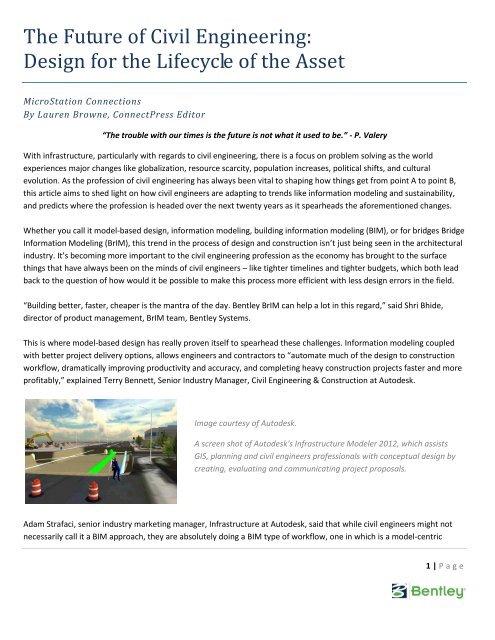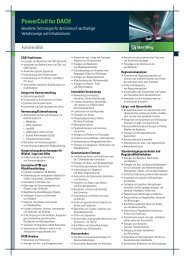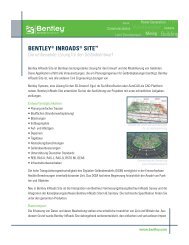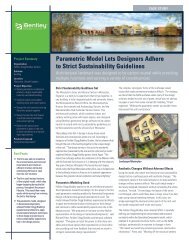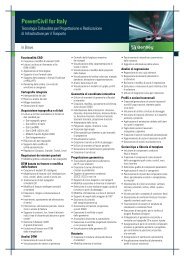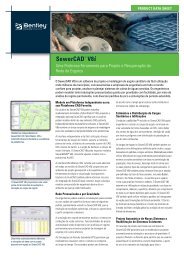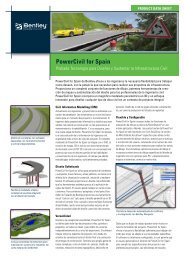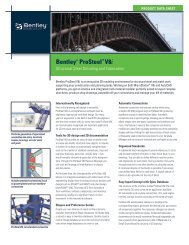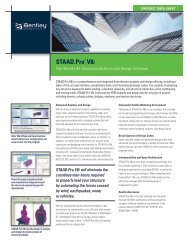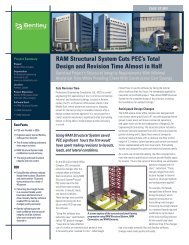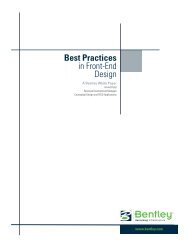The Future of Civil Engineering: Design for the ... - FTP - Bentley
The Future of Civil Engineering: Design for the ... - FTP - Bentley
The Future of Civil Engineering: Design for the ... - FTP - Bentley
Create successful ePaper yourself
Turn your PDF publications into a flip-book with our unique Google optimized e-Paper software.
<strong>The</strong> <strong>Future</strong> <strong>of</strong> <strong>Civil</strong> <strong>Engineering</strong>:<br />
<strong>Design</strong> <strong>for</strong> <strong>the</strong> Lifecycle <strong>of</strong> <strong>the</strong> Asset<br />
MicroStation Connections<br />
By Lauren Browne, ConnectPress Editor<br />
“<strong>The</strong> trouble with our times is <strong>the</strong> future is not what it used to be.” - P. Valery<br />
With infrastructure, particularly with regards to civil engineering, <strong>the</strong>re is a focus on problem solving as <strong>the</strong> world<br />
experiences major changes like globalization, resource scarcity, population increases, political shifts, and cultural<br />
evolution. As <strong>the</strong> pr<strong>of</strong>ession <strong>of</strong> civil engineering has always been vital to shaping how things get from point A to point B,<br />
this article aims to shed light on how civil engineers are adapting to trends like in<strong>for</strong>mation modeling and sustainability,<br />
and predicts where <strong>the</strong> pr<strong>of</strong>ession is headed over <strong>the</strong> next twenty years as it spearheads <strong>the</strong> a<strong>for</strong>ementioned changes.<br />
Whe<strong>the</strong>r you call it model-based design, in<strong>for</strong>mation modeling, building in<strong>for</strong>mation modeling (BIM), or <strong>for</strong> bridges Bridge<br />
In<strong>for</strong>mation Modeling (BrIM), this trend in <strong>the</strong> process <strong>of</strong> design and construction isn’t just being seen in <strong>the</strong> architectural<br />
industry. It’s becoming more important to <strong>the</strong> civil engineering pr<strong>of</strong>ession as <strong>the</strong> economy has brought to <strong>the</strong> surface<br />
things that have always been on <strong>the</strong> minds <strong>of</strong> civil engineers – like tighter timelines and tighter budgets, which both lead<br />
back to <strong>the</strong> question <strong>of</strong> how would it be possible to make this process more efficient with less design errors in <strong>the</strong> field.<br />
“Building better, faster, cheaper is <strong>the</strong> mantra <strong>of</strong> <strong>the</strong> day. <strong>Bentley</strong> BrIM can help a lot in this regard,” said Shri Bhide,<br />
director <strong>of</strong> product management, BrIM team, <strong>Bentley</strong> Systems.<br />
This is where model-based design has really proven itself to spearhead <strong>the</strong>se challenges. In<strong>for</strong>mation modeling coupled<br />
with better project delivery options, allows engineers and contractors to “automate much <strong>of</strong> <strong>the</strong> design to construction<br />
workflow, dramatically improving productivity and accuracy, and completing heavy construction projects faster and more<br />
pr<strong>of</strong>itably,” explained Terry Bennett, Senior Industry Manager, <strong>Civil</strong> <strong>Engineering</strong> & Construction at Autodesk.<br />
Image courtesy <strong>of</strong> Autodesk.<br />
A screen shot <strong>of</strong> Autodesk's Infrastructure Modeler 2012, which assists<br />
GIS, planning and civil engineers pr<strong>of</strong>essionals with conceptual design by<br />
creating, evaluating and communicating project proposals.<br />
Adam Strafaci, senior industry marketing manager, Infrastructure at Autodesk, said that while civil engineers might not<br />
necessarily call it a BIM approach, <strong>the</strong>y are absolutely doing a BIM type <strong>of</strong> workflow, one in which is a model-centric<br />
1 | P a g e
approach. “We started to see it with land development engineers as a way to better coordinate <strong>the</strong> architect and o<strong>the</strong>r<br />
disciplines on a project. But what we’ve seen lately is this idea that BIM is extending into road and highway projects where<br />
you’re able to build a very rich model and use it <strong>for</strong> things like driving visualization, simulation, analysis, and quantity take<br />
<strong>of</strong>f.”<br />
In <strong>the</strong> case <strong>of</strong> bridge design, Bhide said he’s seen <strong>the</strong> bridge industry change in <strong>the</strong> last five years to include more BrIM:<br />
“Demand <strong>for</strong> improved modeling, true-to-life details, constructability, and better integration <strong>of</strong> <strong>the</strong> real-time data<br />
between <strong>the</strong> multiple disciplines involved in a bridge project has been steadily increasing <strong>for</strong> a number <strong>of</strong> reasons:<br />
1. reduced construction costs with economical designs<br />
2. improved quantity take-<strong>of</strong>fs<br />
3. realistic visualization <strong>for</strong> selling <strong>the</strong> project<br />
4. virtual drive-thru.”<br />
As Bhide explained, <strong>Bentley</strong>’s BrIM approach that <strong>the</strong>y developed was in response to more <strong>of</strong> <strong>the</strong> industry needing to<br />
provide a virtual data model <strong>for</strong> all <strong>of</strong> <strong>the</strong> bridge lifecycle.<br />
Ano<strong>the</strong>r reason why model-based design is being used more <strong>of</strong>ten is because <strong>of</strong> government organizations like <strong>the</strong> GSA<br />
and U.S. Army Corps <strong>of</strong> Engineers mandating <strong>the</strong> process <strong>of</strong> <strong>the</strong>ir projects. With government support, o<strong>the</strong>rs are following<br />
suit, like transportation agencies. In addition, in one example, “<strong>the</strong>re’s a large land owner in Texas that mandated BIM not<br />
only <strong>for</strong> building projects but <strong>for</strong> any associated land development projects,” said Strafaci.<br />
While model-based design is a newer process that is catching on in <strong>the</strong> civil engineering industry, sustainability and green<br />
engineering is not. With sustainable design and construction getting so much attention <strong>the</strong>se days, it’s interesting to<br />
examine where civil engineering stands with this green uptake.<br />
Strafaci said sustainable design is definitely prevalent in <strong>the</strong> civil realm, but it’s nothing new because it’s something <strong>the</strong><br />
civil engineer has been doing <strong>for</strong> a long time – <strong>the</strong> only difference is now it is labeled as sustainable design. “So <strong>for</strong><br />
example, <strong>the</strong>re are requirements around a land development project or a transportation project. <strong>The</strong> civil engineer does<br />
an analysis be<strong>for</strong>e <strong>the</strong> development to figure out how much stormwater run-<strong>of</strong>f is going to come <strong>of</strong>f that site. And <strong>the</strong>n<br />
<strong>the</strong>y need to demonstrate that as a result <strong>of</strong> <strong>the</strong> development, <strong>the</strong>y’re not increasing <strong>the</strong> amount <strong>of</strong> run-<strong>of</strong>f coming <strong>of</strong>f<br />
and <strong>the</strong>y’re not negatively impacting <strong>the</strong> water quality,” explained Strafaci.<br />
In <strong>the</strong> simplest <strong>for</strong>m <strong>of</strong> sustainability every project could be more or less green, just depending on how much energy,<br />
water and materials are used <strong>for</strong> <strong>the</strong> design, construction and operation. Bhide explained <strong>the</strong>re has been a “renewed<br />
awareness” in <strong>the</strong> choices made to need to build bridges more efficiently and less expensively, and that sustainability is<br />
being sewn into projects to help meet <strong>the</strong>se needs while not compromising <strong>the</strong> resources <strong>of</strong> future generations.<br />
“Increased consumption <strong>of</strong> recoverable industrial wastes and byproducts in bridges, accelerated bridge construction, and<br />
design using high per<strong>for</strong>mance materials <strong>for</strong> long service lives <strong>of</strong> 75 or 100 years are a few sustainable strategies that are<br />
becoming very popular,” said Bhide.<br />
2 | P a g e
Photo courtesy <strong>of</strong> La DOTD<br />
Bennett brings up <strong>the</strong> good point that through s<strong>of</strong>tware tools that make it easy <strong>for</strong> model-based design, it encourages<br />
smarter choices with <strong>the</strong>se sustainability factors and engineers can “greatly increase <strong>the</strong> odds <strong>of</strong> a sustainable outcome…<br />
It enables civil engineers and designers to understand <strong>the</strong> environmental impact <strong>of</strong> every design element early in <strong>the</strong><br />
design process—long be<strong>for</strong>e <strong>the</strong>y make critical design decisions about site location, stormwater management or material<br />
movement.”<br />
Even though <strong>the</strong> concept <strong>of</strong> sustainability isn’t new to civil engineers, <strong>the</strong> incentives to design civil aspects <strong>of</strong> a project as<br />
green is more a focus now than ever with <strong>the</strong> popularity <strong>of</strong> <strong>the</strong> LEED rating system. Many <strong>of</strong> <strong>the</strong> credits in LEED are civilfocused<br />
with credits in water resources and stormwater management.<br />
In addition, Strafaci notes that <strong>the</strong>re’s been an emergence <strong>of</strong> new rating systems that support sustainable practices in civil<br />
engineering. He has heard <strong>of</strong> a green highway initiative, not a <strong>for</strong>mal rating system yet, in which “a number <strong>of</strong> engineering<br />
teams and DOTs have gotten toge<strong>the</strong>r to try and put toge<strong>the</strong>r guidelines on designing green highways with things like <strong>the</strong><br />
pavement you use (<strong>for</strong> example permeable pavement), how you manage drainage, and reducing <strong>the</strong> impacts <strong>of</strong><br />
transportation systems.”<br />
And so with systems like model-based design and concepts like sustainability paving <strong>the</strong> future, what lies ahead in <strong>the</strong><br />
future <strong>for</strong> civil engineering? It can be a little daunting to think about <strong>the</strong> future <strong>of</strong> infrastructure, but in general it seems<br />
only natural to predict that more cost-effect, high quality, more sustainable designs in less time with less mistakes is a safe<br />
bet.<br />
Bennett noted that over <strong>the</strong> next 20-25 years, $41 trillion dollars will be spent on infrastructure projects globally, with a<br />
heavy focus on Asia. This includes:<br />
• $22.61 trillion in water with $9 trillion alone <strong>of</strong> that to be spent in Asia<br />
• $9 trillion in electricity with $4.23 trillion to be spent in Asia<br />
• $7.8 trillion in road and rail with $2.11 trillion to be spent in Asia<br />
• $1.59 trillion in airports and seaports with $.5 trillion to be spent in Asia<br />
A perfect example <strong>of</strong> designing with <strong>the</strong> lifecycle in mind: <strong>The</strong> I-<br />
10 Twin Span over Lake Pontchartrain in Louisiana was designed<br />
<strong>for</strong> a 100-year service life. <strong>The</strong> project is one <strong>of</strong> <strong>Bentley</strong>'s 2011<br />
Be Inspired Finalists and is <strong>the</strong> largest public works project.<br />
With all <strong>of</strong> this money that will be spent and sustainability on <strong>the</strong> minds <strong>of</strong> everyone, both Strafaci and Bhide agree that it<br />
will be critical <strong>for</strong> civil engineers and project owners to start thinking more about <strong>the</strong> lifecycle <strong>of</strong> <strong>the</strong> project and how to<br />
3 | P a g e
design <strong>the</strong> project <strong>for</strong> <strong>the</strong> cost <strong>of</strong> <strong>the</strong> entire life. “What you’re starting to see with some <strong>of</strong> <strong>the</strong>se larger projects, <strong>the</strong>se<br />
public-private partnerships, <strong>the</strong>se design-build-operate types <strong>of</strong> contracts, is that companies aren’t just building <strong>the</strong><br />
highway, but <strong>the</strong>y are building it and <strong>the</strong>n signing on to manage it as a <strong>for</strong>-pr<strong>of</strong>it business <strong>for</strong> say, twenty to thirty years,”<br />
said Strafaci.<br />
Strafaci also believes that to complement this bigger interest in designing <strong>for</strong> <strong>the</strong> long term, it’s going to require <strong>the</strong><br />
technology to change in order to facilitate this handling vastly more amounts <strong>of</strong> in<strong>for</strong>mation. <strong>The</strong> models will be much<br />
richer because <strong>the</strong>y won’t just be used <strong>for</strong> design and driving construction, but also <strong>for</strong> operating <strong>the</strong> project in <strong>the</strong> future,<br />
said Strafaci.<br />
In addition, Bhide said <strong>the</strong> <strong>for</strong> bridge design, “increased use <strong>of</strong> pre-fabricated bridge elements and systems, and<br />
accelerated bridge construction will continue to be main strategies <strong>for</strong> delivering bridge projects in <strong>the</strong> U.S. <strong>for</strong> <strong>the</strong> long<br />
haul.”<br />
With a design’s lifecycle on <strong>the</strong> <strong>for</strong>efront, <strong>the</strong> process <strong>of</strong> model-based design and BrIM can make this transition <strong>of</strong><br />
designing <strong>for</strong> <strong>the</strong> lifecycle easier. Simply stated, <strong>Bentley</strong> explains <strong>the</strong> cornerstone <strong>of</strong> BrIM is data reuse. <strong>Bentley</strong> considers<br />
<strong>the</strong> bridge in<strong>for</strong>mation model to have <strong>the</strong> capability to be <strong>the</strong> in<strong>for</strong>mation source <strong>of</strong> <strong>the</strong> bridge asset, making BrIM<br />
applicable to <strong>the</strong> entire bridge lifecycle.<br />
<strong>Civil</strong> engineers, as all infrastructure pr<strong>of</strong>essionals do, have <strong>the</strong>ir work cut out <strong>for</strong> <strong>the</strong>m: <strong>the</strong>se are changing times where<br />
bridges can longer be built without construction waste being a factor, roads can no longer be built without factoring in<br />
sustainability aspects like permeable pavement, and successful projects are focused on model-based design from concept<br />
all <strong>the</strong> way through operations.<br />
Autodesk and <strong>Bentley</strong> echo each o<strong>the</strong>r’s ideas on <strong>the</strong> future <strong>of</strong> <strong>the</strong> civil engineering industry lying in <strong>the</strong> adoption <strong>of</strong><br />
model-based design, which will clear <strong>the</strong> way <strong>for</strong> designing <strong>for</strong> <strong>the</strong> lifecycle <strong>of</strong> projects. And <strong>the</strong> rest, as <strong>the</strong>y (will) say,<br />
(will be) history.<br />
Lauren Browne is a graduate from Nor<strong>the</strong>rn Arizona University where she received a Bachelor <strong>of</strong> Arts in English and a<br />
minor in journalism. O<strong>the</strong>r than wordsmithing, Lauren enjoys running, hiking, biking, climbing, and really anything<br />
outdoors.<br />
4 | P a g e


